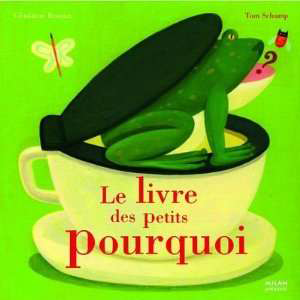 by Ghislaine Roman
by Ghislaine Roman
Dans cet album, chaque question introduit la suivante. C’est ainsi que l’enfant évolue d’une interrogation sur le goût salé des larmes à celle sur l’immensité du ciel. Amusantes et parfois désarmantes, ces questions abordent les choses de la vie et le fonctionnement de l’univers dont l’enfant se fait sa propre idée, comme en témoignent les illustrations.
Strategies/Skills Used
Reading Strategy 2: Predict what will be learned or what will happen.
Reading Strategy 4: Self-monitor and self-correct.
Reading Strategy 6: Connect what you read with what you already know.
Reading Strategy 7: Determine the most important ideas and events and the relationship between them.
Reading Strategy 8: Extract information from text, charts, graphs, maps and illustrations.
Reading Strategy 11: Make inferences and draw conclusions.
Reading Strategy 12: Reflect and respond.
Writing Skill 1: I generate ideas in a variety of ways.
Writing Skill 2: I organize my ideas based on my purpose for writing.
Writing Skill 6: I choose the tone and point of view that suit my writing purpose.
 TEACHING THE ACTIVITY: PRE-READING
TEACHING THE ACTIVITY: PRE-READING
(1) Make a copy, or create cards, of each of the 16 questions in the book for the activity Thinking Like An Author.
(2) Have the students work in small groups and imagine themselves as the author. Using all 16 text excerpts, students are invited to place the questions in the order that they predict they will appear in the book. Student groups will discuss and create “the story” and make predictions about the plot.
(3) Have groups share their results with the class. Have each group hold up their first question. Compare and contrast results. Discuss why they chose their placement and reasons for possible differences. Repeat this process for all 16 questions.
(4) Lead a discussion about their plot predictions and what they noticed throughout this process. Call their attention to the clues and the sequencing. Notice how each question leads to the next.
 TEACHING THE ACTIVITY: DURING READING
TEACHING THE ACTIVITY: DURING READING
 (5) Using the strategy Question/Answer Relationship and l’organisateur graphique Les relations: Questions/Réponses, teach the three different kinds of questions and answers (literal, inferential and personal response/evaluative) used in reading. As you read the book, stop after three questions of your choosing to discuss what kind of questions they are and how they could be manipulated to become another type of question.
(5) Using the strategy Question/Answer Relationship and l’organisateur graphique Les relations: Questions/Réponses, teach the three different kinds of questions and answers (literal, inferential and personal response/evaluative) used in reading. As you read the book, stop after three questions of your choosing to discuss what kind of questions they are and how they could be manipulated to become another type of question.
(6) Finish reading the story.
(7) Post the final question of the story, “Pourquoi les grands ne répondent-ils pas aux <<pourquoi>> des enfants?” up on the wall. Have each student write “une réponse de réflexion” (personal response/evaluative answer) to it, in a thought bubble.
(8) Invite a Gallery Tour to explore and share the students’ ideas. Following the Gallery Tour, allow students time to complete or elaborate their ideas if need be.
(9) Post all of the answers up on the wall around the big question to validate their ideas and help inspire new ones.
 TEACHING THE ACTIVITY: POST-READING
TEACHING THE ACTIVITY: POST-READING
 (10) Have students select from the book a question that interests them to explore further. Using the strategy Journalists’ Questions as a guide and using four copies of l’organisateur graphique Les questions de journaliste, students will formulate a variety of possible answers to this big question.
(10) Have students select from the book a question that interests them to explore further. Using the strategy Journalists’ Questions as a guide and using four copies of l’organisateur graphique Les questions de journaliste, students will formulate a variety of possible answers to this big question.
(11) Have students do some research (computer, library, etc.) to try and find the scientific answers (literal answers) to the question and record their findings on one Graphic Organizer. On another Graphic Organizer, they will record their own personal responses. On the final two Graphic Organizers, students will interview two other people (e.g. a parent, teacher, coach, friend) to gather more possible answers.
(12) Using all of the information gathered above, students will create their own newspaper article to report their findings. Be sure to include in the evaluation rubric that students must identify and represent all three types of questions and answers (literal, inferential and personal response/evaluative) in their article.
(13) Provide opportunities for students to share and read their articles to others (e.g. author’s chair, small groups, buddy classes).
(14) Gather all the newspaper articles to create a class newspaper, “Le journal des petits pourquoi.”
 TEACHING THE ACTIVITY: POST-READING EXTENSION
TEACHING THE ACTIVITY: POST-READING EXTENSION
(15) In Adrienne Gear’s book Lecteurs engagés, cerveaux branches, refer to the chapter “Se poser des questions” and select another book from her book list on pages 51–52 that lends itself well to asking questions. Have students create their own questions based on the book selected, and have them evaluate their questions to see if their questioning skills help increase their understanding of the story. Use any of the Graphic Organizers on pages 53–59 to support your lesson.